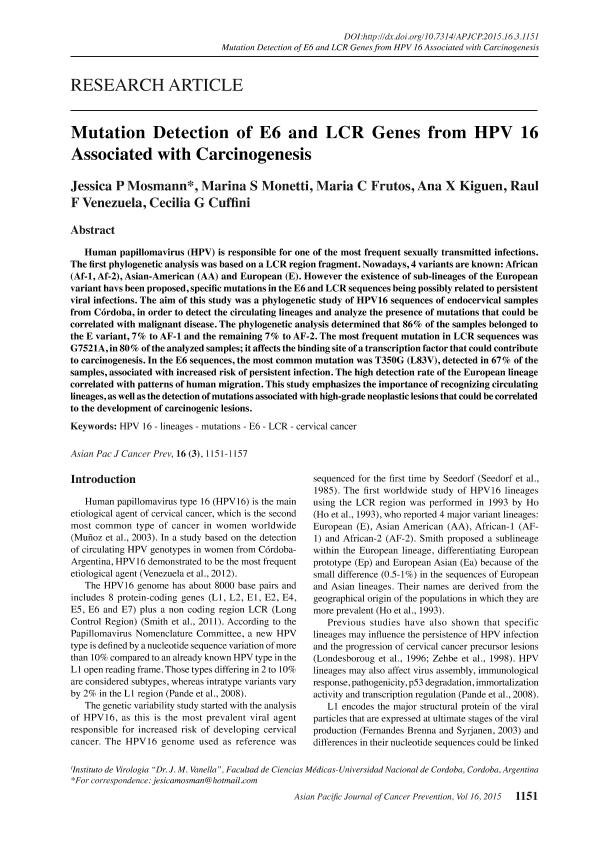Artículo
Mutation detection of E6 and LCR genes from HPV 16 associated with carcinogenesis
Mosmann, Jessica Paola ; Monetti, Marina Soledad
; Monetti, Marina Soledad ; Frutos, Maria Celia
; Frutos, Maria Celia ; Kiguen, Ana Ximena; Venezuela, Raul Fernando; Cuffini, Cecilia Gabriela
; Kiguen, Ana Ximena; Venezuela, Raul Fernando; Cuffini, Cecilia Gabriela
 ; Monetti, Marina Soledad
; Monetti, Marina Soledad ; Frutos, Maria Celia
; Frutos, Maria Celia ; Kiguen, Ana Ximena; Venezuela, Raul Fernando; Cuffini, Cecilia Gabriela
; Kiguen, Ana Ximena; Venezuela, Raul Fernando; Cuffini, Cecilia Gabriela
Fecha de publicación:
03/2015
Editorial:
Asian Pacific Organization Cancer Prevention
Revista:
Asian Pacific Journal of Cancer Prevention
ISSN:
1513-7368
e-ISSN:
1513-7368
Idioma:
Inglés
Tipo de recurso:
Artículo publicado
Clasificación temática:
Resumen
Human papillomavirus (HPV) is responsible for one of the most frequent sexually transmitted infections. The first phylogenetic analysis was based on a LCR region fragment. Nowadays, 4 variants are known: African (Af-1, Af-2), Asian-American (AA) and European (E). However the existence of sub-lineages of the European variant havs been proposed, specific mutations in the E6 and LCR sequences being possibly related to persistent viral infections. The aim of this study was a phylogenetic study of HPV16 sequences of endocervical samples from Córdoba, in order to detect the circulating lineages and analyze the presence of mutations that could be correlated with malignant disease. The phylogenetic analysis determined that 86% of the samples belonged to the E variant, 7% to AF-1 and the remaining 7% to AF-2. The most frequent mutation in LCR sequences was G7521A, in 80% of the analyzed samples; it affects the binding site of a transcription factor that could contribute to carcinogenesis. In the E6 sequences, the most common mutation was T350G (L83V), detected in 67% of the samples, associated with increased risk of persistent infection. The high detection rate of the European lineage correlated with patterns of human migration. This study emphasizes the importance of recognizing circulating lineages, as well as the detection of mutations associated with high-grade neoplastic lesions that could be correlated to the development of carcinogenic lesions.
Palabras clave:
Cervical Cancer
,
E6
,
Hpv 16
,
Lcr
,
Lineages
,
Mutations
Archivos asociados
Licencia
Identificadores
Colecciones
Articulos(CCT - CORDOBA)
Articulos de CTRO.CIENTIFICO TECNOL.CONICET - CORDOBA
Articulos de CTRO.CIENTIFICO TECNOL.CONICET - CORDOBA
Citación
Mosmann, Jessica Paola; Monetti, Marina Soledad; Frutos, Maria Celia; Kiguen, Ana Ximena; Venezuela, Raul Fernando; et al.; Mutation detection of E6 and LCR genes from HPV 16 associated with carcinogenesis; Asian Pacific Organization Cancer Prevention; Asian Pacific Journal of Cancer Prevention; 16; 3; 3-2015; 1151-1157
Compartir
Altmétricas



